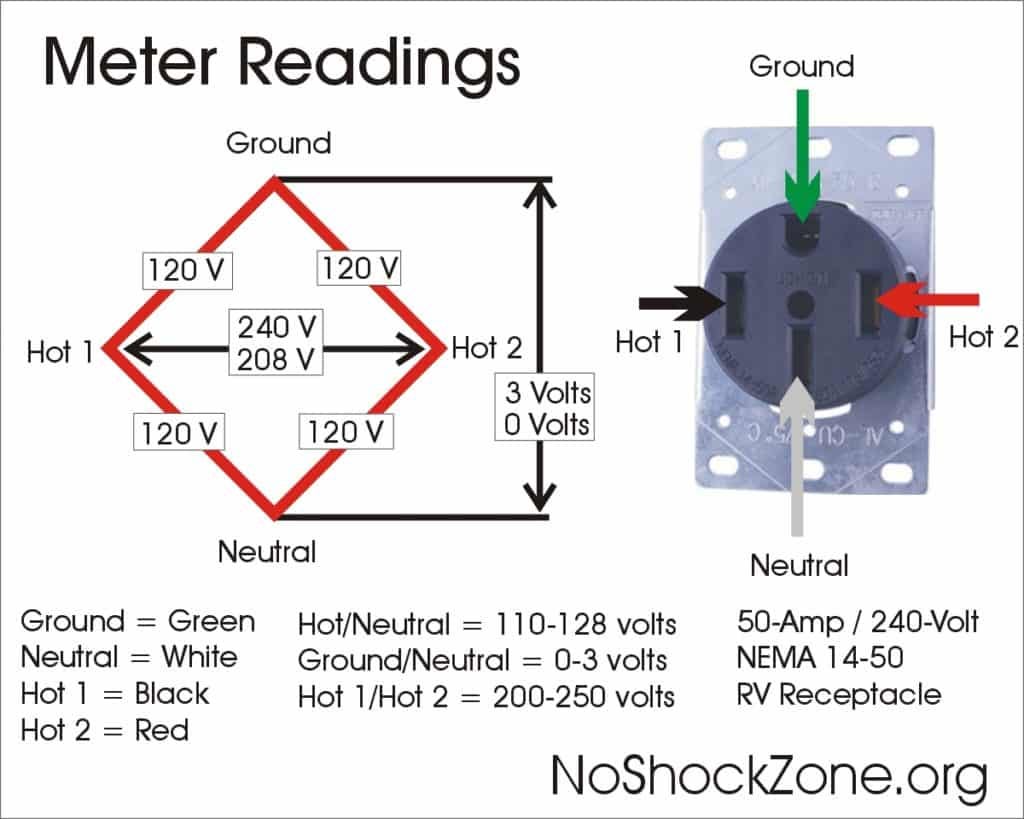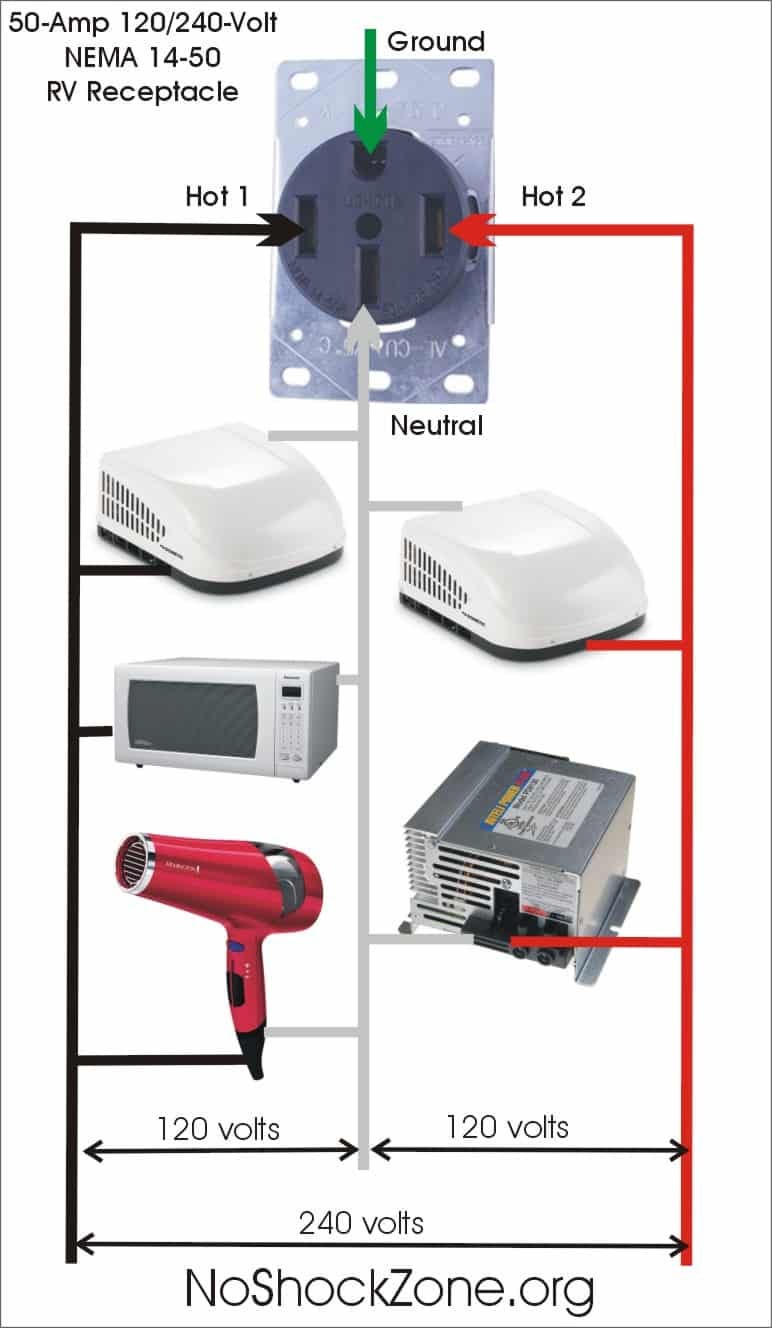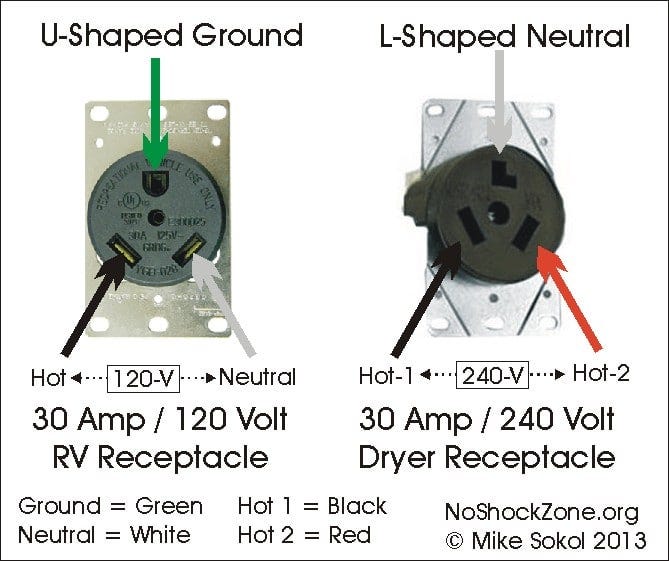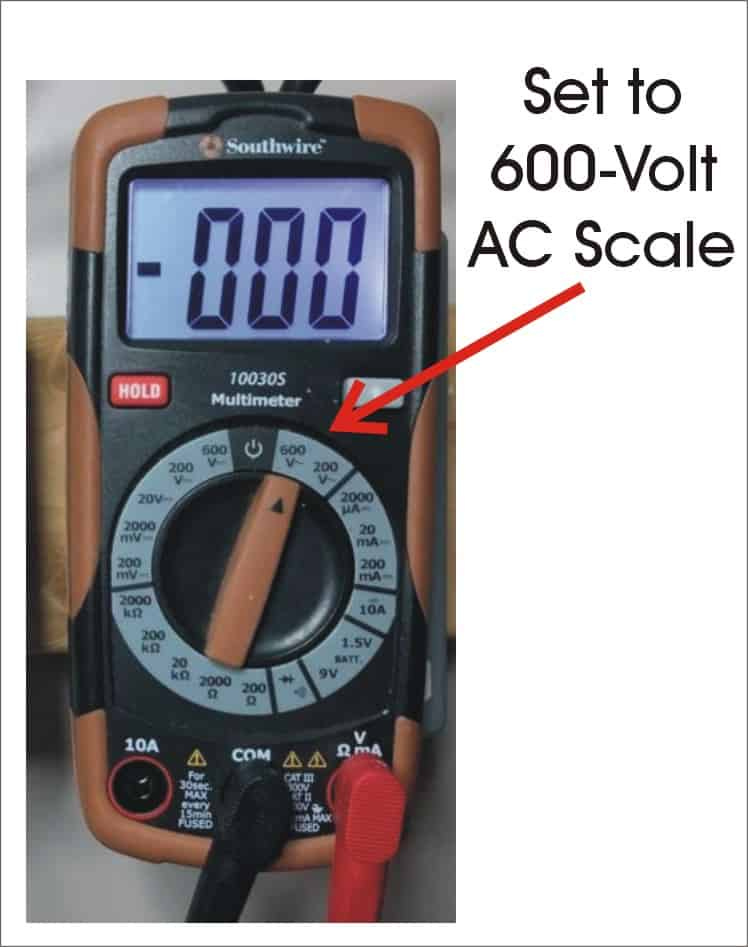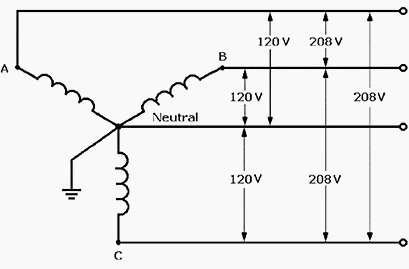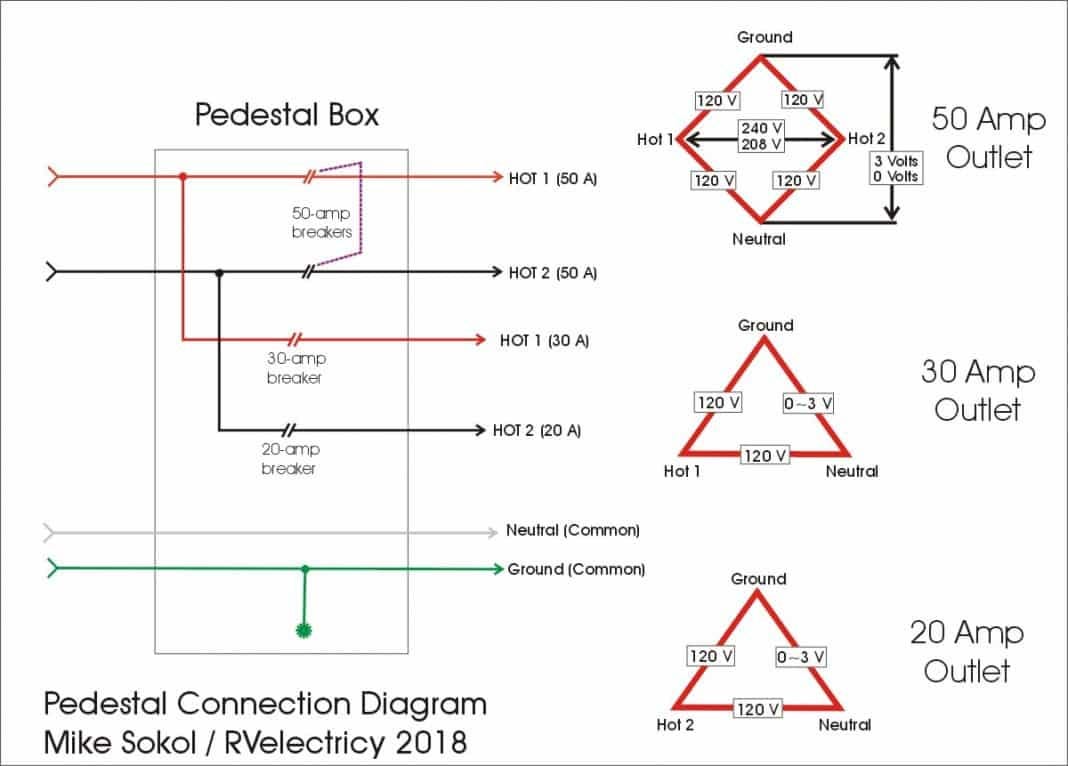Dear Readers,
Here’s a two-fer (or possibly three-fer) article for you where I combine a few of my previous articles on 50-, 30- and 20-amp pedestal outlet wiring. Have fun…
Power principles: How 20-, 30- and 50-amp shore power works
Tons of confusion on this topic, from manufacturing level on down to beginner RV owners. So I’ll cover the basics of 50-amp pedestal power at an Intermediate level, and create future articles at Easy and Expert levels. I’ll save the Expert level instruction for my RV Technician clinics, since that will necessarily deal with potentially deadly level troubleshooting, and how to protect you all from dangerous situations.
So, as always, if you don’t feel comfortable doing any of these measurements or basic troubleshooting techniques, DO NOT PROCEED. Find someone that can help you get better acquainted with electricity, and not as a forced introduction.
So, what is a 50-amp RV outlet, and how is it actually wired?
Technically it’s called a “receptacle,” not an “outlet,” by any professional technician, electrician or engineer, but I let it slide most of the time when I’m discussing it with entry-level RV owners. However, its official name is a NEMA 14-50R receptacle, and it’s exactly the same 240-volt “outlet” often found in your kitchen to power an electric oven. And that’s why if you go into your local big box store you should easily find them on the rack. The only real difference between one for your kitchen and one for your RV is the RV version needs to be mounted in a rainproof enclosure rated for outside exposure, while a kitchen version won’t be waterproof since it should be mounted on an interior wall behind the stove or oven.
How are 50-amp outlets wired?
Well, it’s called a 125/250-volt AC 2-pole receptacle, with the 125/250-volt rating describing how much max voltage it can have between the neutral wire and each pole (125 volts), as well as how much voltage it has between the two poles/legs (250 volts). It’s also rated for a maximum current of 50 amperes … but much more on that in a future advanced article.
As many of you have seen in my previous articles, I’ve drawn up a diamond measurement chart showing all the voltage levels you’ll find in a 50-amp outlet. Now, this isn’t just a suggestion – it’s actual code. So if someone deviates from this wiring configuration either by accident or on purpose, it’s a code violation and should never have passed inspection.
Measurements
You’ll see that I’ve called out possible voltage measurements you should find with a digital voltmeter. More on this below, but know that it’s possible to measure a nominal 208 volts between the 2 hot legs (poles) and still be perfectly acceptable, since campgrounds are now allowed by code to run 3-phase power to the pedestals (yes, they really are).
This won’t impact you at all except to know that if you read around 120 volts from the neutral (bottom contact) to either of the hot legs (poles), it’s completely normal to measure 208 volts from leg-to-leg. However, you must NEVER measure 0 volts between the two hot legs on a 50-amp outlet since that will allow the neutral wire to carry too much current, overheat and possibly burn up.
Where does this power come from?
Well, if you’ve ever looked at a power pole with transformers and wondered what it was all about, here’s a basic diagram. Those wires up overhead generally carry between 7,000 and 11,000 volts of potential, which the transformers step down to 240 volts. And there’s a center-tap on that 240-volt transformer winding that further divides it into 120/120 volts on each leg. So if you have a 240-volt appliance you connect it between the two hot legs on the outlet. And if you have a 120-volt appliance you connect it between one of the hot legs and the neutral. It’s really that simple.
How much power can I get from a 50-amp outlet?
That’s the most relevant question, and the answer is 12,000 watts. Here’s why. While it seems confusing to think about a 50-amp outlet as having 100 amperes of total current available at 120 volts, that’s actually correct. That’s because there’s a 2-pole circuit breaker in the pedestal (at least, there should be), and each pole is rated for a maximum current of 50 amperes before it trips. So you can pull up to 50 amps from one pole, and another 50 amps from the other pole.
Now, neither pole can exceed 50 amperes by itself, but you can indeed get 50 amps from each pole (or leg) and that totals up to 100 amperes of current at 120 volts.
If you look at how your 50-amp shore-powered RV is wired, every outlet and most appliances (except for some large coaches) are connected to the neutral wire and one of the two poles. So everything is being fed 120 volts, including your electric water heater, microwave oven, rooftop air conditioner, DC converter, and every wall outlet you plug your computer, hair dryer, television and anything else into.
A well-designed electrical panel in your RV will try to balance these loads, so the water heater and microwave will be on different legs, and if there are two rooftop air conditioners, each one will be connected to the two different shore power legs. That’s so as not to overload either of the two 50-amp circuits, which will trip both poles on the breaker.
Now for a little Ohm’s Law…
But don’t get worried as the math is really simple. To calculate wattage, all you have to do is multiply the Voltage (Electrical Potential) by the Amperage (Current Flow) and you’ll come up with Wattage (Power). So each of the two legs of your 50-amp outlet calculates as 120 volts x 50 amperes = 6,000 watts. And since you have two identical 50-amp legs, you can find the total wattage by simple addition of the two legs. Thus 6,000 watts + 6,000 watts = 12,000 watts.
Don’t wire 240 volts into a 30-amp outlet
Here is what a 30-amp/120-volt RV outlet looks like compared to a 30-amp/240-volt dryer outlet. See why electricians can be easily confused? While it should be impossible to plug a TT-30 shore power cord into a 240-volt dryer outlet, many have tried. And, of course, it’s easy for a residential electrician to get confused and wire an actual RV 30-amp outlet (NEMA TT-30 Receptacle) with 2-pole 240-volt power. That only takes a few seconds to destroy much of your RV’s electrical system.
Correct 20- and 30-amp pedestal wiring
And this is how 20- and 30-amp RV outlets are supposed to be wired. Note that all pedestals should be mounted with the outlets oriented so that the ground is UP. This allows your shore power cord and/or surge protector to hang down properly. If they’re mounted with the ground in the downward position, your surge protector won’t hang properly, often falling out of the pedestal outlet or filling up with rain water.
If you’re going to have a 30-amp RV outlet wired up for your RV when it’s parked at home, be sure to show this to your electrician before he makes a costly mistake. Plus, it’s really a good idea for you to measure every new or unknown RV outlet for correct voltage BEFORE you plug in your expensive RV. And that’s also a great reason to use something like a full protection Surge Guard on your RV’s shore power line. It’s cheap insurance since it won’t let a 240-volt wiring mistake reach your RV electrical system.
Meter measurements
If you’re going to be measuring voltages with a digital meter, you’ll want to set it to the 400- or 600-volt AC scale BEFORE plugging the probes into the outlet. You’ll see there’s a red probe and a black probe on the meter, but for AC (Alternating Current) it doesn’t matter which color probe goes in which contact on the outlet. However, that’s not the case for 12-volt DC measurements, which do indeed have a polarity. But more on that in a future article.
You’ll also see in the diagram at the bottom of this page that the 50-amp outlet can measure either 240 volts or 208 volts from Hot-1 to Hot-2, but it must never measure 0 volts between the hot legs. That would indicate that the campground had miswired the outlet with a single leg of 120-volt power jumpered between Hot-1 and Hot-2 on the 50-amp outlet. That would cause the neutral current to be additive rather than subtractive. And that would allow 70, 80 or 90+ amperes of current to flow through your neutral wiring, melting your shore power plug and possibly destroying the wiring in your generator transfer switch.
Why is 208 volts acceptable?
The reason that it could read 240 or 208 volts between the two hot legs is that since 2017 the National Electrical Code (NEC) has allowed 3-phase 120/208-volt WYE power to be distributed in campgrounds. That’s perfectly safe if the electricians wiring the pedestals understand 3-phase power, but it’s possible to accidentally create some pretty serious wiring errors with 3-phase service panels that could result in massive RV electrical system damages. So that’s a topic for my advanced RV technician classes.
Quick reference
Finally, here’s a full-page graphic of just my voltage diagram that you can print out and keep for reference. After 50+ years of doing electrical work I have all of these diagrams in my head (and possibly my DNA), but you’ll want to refer to this diagram until you have it committed to memory. After that, it’s smooth sailing – or smooth RVing – as the case may be….
Let’s play safe out there…. Mike






